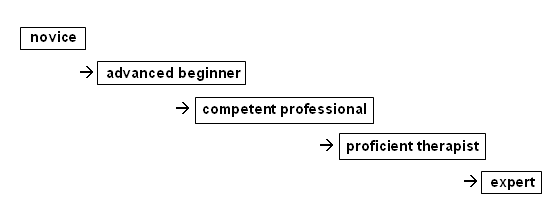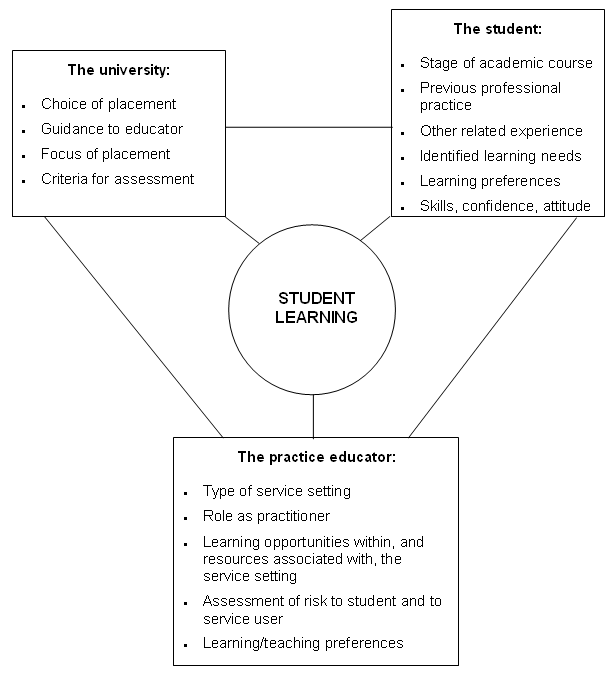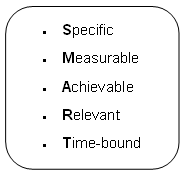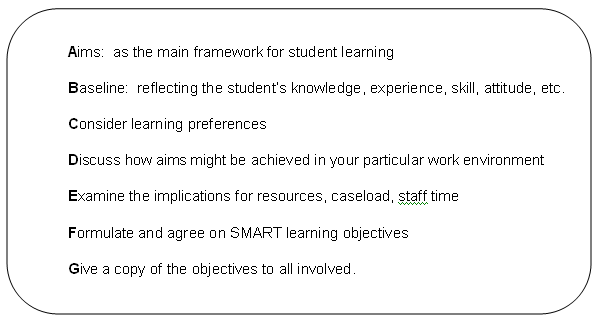Defining the learning experience
This section looks at the ways in which a student develops skills and how you can identify what learning is appropriate for students at different stages of development.
Developing competence
Professional practice is vital in enabling students to 'develop, demonstrate and achieve competence to practise. COT (2000) Although students acquire much of their knowledge base at university, it is through practice education that they see the applications of that knowledge, and become aware of the realities of practice and the effects of current legislation, politics and priorities. It will be your role, as a practice educator, to help students develop competence through their exposure to practice, for the ultimate benefit of service users.
What is competence?
Competence can be defined as the norms of effective practice in any given profession. This suggests that competence is not static, and that as service delivery and targets for effectiveness change, so too will what is defined as competence. Competence to practise covers a wide range of aspects: not just knowledge, understanding and the ability to take appropriate action, but a wide range of personal qualities.
Professional Bodies expect competent practitioners to be critically reflective, proactive, innovative and adaptable, and capable of working on their own and in a team, in a climate of social, technical and health care change. As well as being able to display attributes and exercise skills that characterise their profession in general, and satisfy the legal requirement to safeguard the public, the competent practitioner would also need to develop attributes and skills appropriate to his/her own service setting.
Becoming competent
There have been several studies of the ways in which individuals acquire knowledge and skills, as they move from being an unskilled beginner to becoming a competent practitioner and then an expert. The most well-known of these were undertaken by Benner (1982), in relation to nursing, and Dreyfus and Dreyfus (1986) with a range of occupations.
Both studies describe the development of competence as a continuum:
 This process can be a long one, with proficiency only developing after around three years in practice, and full development to becoming an expert perhaps taking 15 years. The ability to reflect, and the development of clinical reasoning, would obviously be integral to this process, as would the development of autonomy.
This process can be a long one, with proficiency only developing after around three years in practice, and full development to becoming an expert perhaps taking 15 years. The ability to reflect, and the development of clinical reasoning, would obviously be integral to this process, as would the development of autonomy.
How does this continuum relate to professional practice education for students? Students operating at the 'novice' level, early in their course, would need to fill gaps in their knowledge, and might gain confidence from working in a more structured environment where there are 'rules' that they can follow. As they progress, they will be more able to relate to the service user as an individual, and will begin to appreciate the multitude of factors that operate in any situation. As students develop competence they will become increasingly able to plan and prioritise, and to reflect on their own, and other's, actions and decisions.
![]() What factors will influence what it is appropriate for a student to learn while on a practice placement with you?
What factors will influence what it is appropriate for a student to learn while on a practice placement with you?
Spend a few minutes considering all aspects of this question, not just what has been covered in this section. Jot down your ideas, and compare them with the notes on the following page.
Factors defining the learning experience
In any situation, but particularly in the workplace, many opportunities for learning will arise, and the student should be encouraged to gain as much benefit as possible from all their experiences.
What we are looking at here is planning for a student's learning - negotiating what they should focus on and aim to achieve, in the light of university requirements, of his/her own learning needs and of the opportunities available in your service setting.
Viewed as a diagram, the factors might look like this :

Negotiating a learning contract and setting personal objectives
One way of defining what learning should occur is through the use of a learning contract and the process of setting learning objectives for the placement. You may already be familiar with this process, but do keep working your way through the rest of the section as the exercises are important.
Objectives/Learning Contract
"A self directed learner is someone who, with or without the help of others, diagnoses his/her learning needs; sets relevant, feasible and measurable objectives; determines generally acceptable standards or criteria which will be applied to assess whether learning has in fact occurred as planned; and finally, formulates a coherent learning agreement or personal curriculum for the course".
(Hammond & Collins 1987)
Students are encouraged from the beginning of the course to be "self-directed" learners and proactive in management of their own professional development.
Hence, personal objectives in the form of a learning contract should be set in parallel with those from the module description and any set within placements themselves.
A Learning Contract Should:
- Allow a student to manipulate the course to meet his/her own needs.
- Result in learning that is meaningful.
- Increase student's self motivation by giving them responsibility for his/her own learning.
- Enable student to define his/her own needs.
- Enable student to problem solve.
- Encourage student to use a wide range of resources and strategies.
Steps a Student Should Take:
- Discuss in the first week the possible learning outcomes for the placement.
- Identify personal learning outcomes to have achieved by the end of the placement.
- Indicate against each outcome strategies and resources he/she will use to meet their learning needs.
- Indicate how he/she is going to demonstrate that the outcomes have been achieved.
- Identify the criteria by which he/she will demonstrate that these outcomes have been achieved.
- Break down each outcome into objectives which should be SMART (specific, measurable, achievable, realistic & time bound) (See further pages for additional information)
- Review these objectives within each weekly supervision session and as the learning outcomes are achieved have them authorised by the educator on the learning contract.
- Revise the objectives in preparation for the following week.
How is the Learning Contract Negotiated?
There are four stages in the initial negotiation:

The learning contract should allow the student to meet the learning outcomes of each professional practice module. The expected outcome should be reasonable and reflect the level of training at which the student is performing. The assessment criteria on the report forms should be used as a guide.
Individual styles of learning contract can be adapted & designed by practice educators but the following headings should be included:
- Aims What do I want to learn?
Long term outcomes to be achieved by the end of the placement.
- Plan of ActionHow will I learn?
Objectives, supervisory agreement, strategies and resources, for example discussion with ......, observation of ...... , reading of ..... tutorial about ......
- Method of Evaluation What form will the evaluation take and who will be involved? How will I know when I have achieved this?
For example, feedback from ....., presentation to ..... observation by.
As each learning outcome is achieved, the educator and the student should sign and date that outcome.
![]() Have a look at the example of a learning contract on the next page. This is only one type & you will see many different styles.
Have a look at the example of a learning contract on the next page. This is only one type & you will see many different styles.
The student will probably come with learning outcomes or aims for the placement set by the university, which will be reflected in the focus of, and criteria for, student assessment. However, outcomes are usually no more than broad statements about the learning process. They cannot take account of the particular nature of the opportunities for learning in your work environment, or of the teaching/learning preferences of you and the student.
Objectives are the particular steps that need to be taken in order for an outcome/aim to be achieved. They describe aspects of performance or behaviour in the learner that contribute to the achievement of the outcome or aim, and provide a means by which a student can demonstrate his/her learning.

If you have not had experience of setting aims and objectives before, it is probably helpful to think about them in relation to everyday activities first, before you try to imagine them in relation to professional practice education.
![]() An aim for many people is to pass their driving test.
An aim for many people is to pass their driving test.
What objectives would need to be realised in order for this aim to be achieved?
Try to write down four to six objectives - steps in the process - that would lead to you passing your driving test. Compare your notes with those given in SR6
The example of passing a driving test is a good one, because it illustrates that there is not just one way of the aim being achieved. Some people may choose to learn only with a driving instructor, others may learn from friends or family - a few may even use a driving simulator or an intensive week of training. The aim itself did not set limits on how it would be fulfilled.
In the same way, the aim in the exercise did not set any time limits for passing the test, and so none were used in the objectives in SR4. However, in many cases, an aim is expressed with a particular time frame in mind - for example, passing your test by your eighteenth birthday. The objectives would then also need to be worded to take this into account.
The outcomes for students on practice placements are likely to have to be achieved within the duration of the placement period, even if this is not expressly stated. You will need to set time aside at the start of the placement to discuss with the student his/her learning needs, establish a baseline (reflecting the student's previous experience, knowledge, skills and stage of training), and negotiate a learning contract with objectives for the first week or two.
One way of ensuring that objectives that contribute to the fulfilment of each outcome are appropriate, is to make sure they are SMART:

In considering the first of these - being specific - it can be a good idea to find answers to questions such as, 'Who?' 'What?' 'Who with?' 'Where?', while answering 'When?' will fulfil the last SMART requirement, by putting it within a time frame. Asking 'With what result?' Will help to ensure the objective is measurable. However, do try to avoid following a 'formula' for the phrasing of objectives - too rigid an approach can sound rather like a game of Cluedo, continually referring, for example, to 'the student, in the treatment room, with the practitioner... '!!
Look back at the objectives you wrote for passing a driving test. Try re-writing them so that they are achieved by the age of 18, and fulfil the SMART criteria above.
Advantages of setting learning objectives
There are a number of advantages to using objectives to structure the learning experience of professional practice students. Objectives will:
- Provide students with clear guidelines as to what is expected of them
- Enable students to focus on specific tasks
- Help to identify what resources are needed to accomplish the outcomes
- Relate immediate efforts to longer-term outcomes, making them seem more achievable
- Provide both student and practice educator with a means of measuring student progress
- Provide a framework which, in the event of the absence of the educator, can be understood and monitored by another colleague
- Provide an opportunity to evaluate the approaches and methods used
- Include a tangible method of accountability.
Avoiding the pitfalls
Care needs to be taken to ensure that some of the common problems with setting learning objectives are avoided. Try not to write objectives that are:
too difficult too complex
too easy over too long a time frame
not measurable over too short a time frame
too numerous irrelevant.
Being SMART should help to avoid most of these! It should also be remembered how broad the notion of competence is - aims and objectives are not just about developing practical skills, but also, for example, increasing a student's knowledge and affecting his/her attitude.
Discussion between you and the student is the key to ensuring that you both have a clear understanding of what the student is aiming to achieve, and that the objectives are appropriate to that aim within your particular service setting. Copies of the objectives should be held by both of you, and it will probably be helpful if other members of the team are aware of what these are.
Above all, it is vital that setting learning objectives is only seen as the beginning of the process. In Part One you saw how student learning depends to a great extent on you, as practice educator, being able to pass on your knowledge, skills and attitudes through discussion and explanation. It is also important that you monitor student progress as s/he works through the learning objectives, and that you provide him/her with constructive feedback through supervision.
This checklist may be helpful in defining the stages to be worked through in setting learning objectives:

Remember that all students will be working towards becoming competent health care practitioners; what is important is the level of autonomy they have achieved in this process.
Whatever expectations there are of the student's learning during professional practice, it will be your actions and attitudes - in guiding and supporting the student, in providing direct teaching, and through ongoing feedback, supervision and assessment - that will be crucial in enabling the student to fulfil his/her learning needs. In the next section we look at the processes of feedback and supervision in more detail.